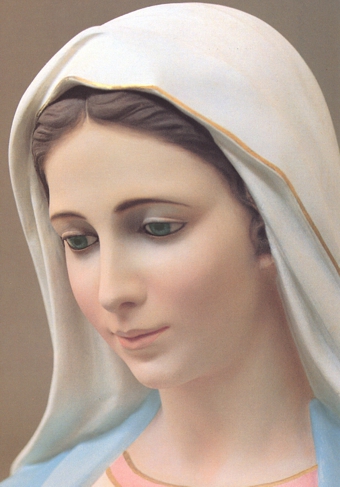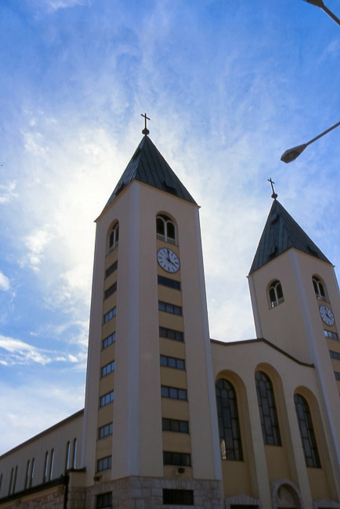
Cardinal Gerhard Müller, prefect of the Congregation for the Doctrine of the Faith.
– Daniel Ibáñez/Catholic News Agency
Cardinal Gerhard Müller has said he expects the Society of St. Pius X, which has always opposed the Second Vatican Council's declarations on religious freedom and ecumenism, to “unreservedly recognize” freedom of religion as a human right, and an obligation to ecumenism.
Lionel:
I "unreservedly recognize" freedom of religion as a human right however I interpret Vatican Council II in harmony with extra ecclesiam nulla salus, as interpreted by the 16th century missionaries.So I affirm the necessity of all people needing to become Catholics for salvation.Since there is no change in the old ecclesiology with Vatican Council II, for me, I affirm the necessity of the non separation of Church and State, since all need to enter the Catholic Church to avoid Hell.This is the priority.
Similarly since Vatican Council II does not contradict the dogma extra ecclesiam nulla salus, ecumenism must be based on an exclusivist ecclesiology for me.I am open to ecumenism as long as it is understood that Vatican Council II indicates that all non Catholics need to enter the Catholic Church formally to avoid Hell.
Similarly the SSPX could also accept Vatican Council II ( Feeneyism).So religious freedom and ecumenism would not be an issue.With Vatican Council II (Feeneyism), Vatican Council II would only be an issue for those who use the theology of Cushingism, as does Cardinal Gerhard Muller.
____________________________
Lionel:
I "unreservedly recognize" freedom of religion as a human right however I interpret Vatican Council II in harmony with extra ecclesiam nulla salus, as interpreted by the 16th century missionaries.So I affirm the necessity of all people needing to become Catholics for salvation.Since there is no change in the old ecclesiology with Vatican Council II, for me, I affirm the necessity of the non separation of Church and State, since all need to enter the Catholic Church to avoid Hell.This is the priority.
Similarly since Vatican Council II does not contradict the dogma extra ecclesiam nulla salus, ecumenism must be based on an exclusivist ecclesiology for me.I am open to ecumenism as long as it is understood that Vatican Council II indicates that all non Catholics need to enter the Catholic Church formally to avoid Hell.
Similarly the SSPX could also accept Vatican Council II ( Feeneyism).So religious freedom and ecumenism would not be an issue.With Vatican Council II (Feeneyism), Vatican Council II would only be an issue for those who use the theology of Cushingism, as does Cardinal Gerhard Muller.
____________________________
In an interview in the June edition of the German publication Herder Korrespondenz, the prefect of the Congregation for the Doctrine of the Faith said that if one “wants to be fully Catholic, one must recognize the Pope and the Second Vatican Council.”
Lionel: No problem here for me.I recognize the pope and accept what he says if it is in accord with Tradition.If it is opposed to Tradition and to the former popes I reject it. I affirm Vatican Council II with Feeneyism and reject the pope's interpretation of Vatican Council II with irrational and non traditional Cushingism. Cushingism is heretical for me.
______________________________
Lionel: No problem here for me.I recognize the pope and accept what he says if it is in accord with Tradition.If it is opposed to Tradition and to the former popes I reject it. I affirm Vatican Council II with Feeneyism and reject the pope's interpretation of Vatican Council II with irrational and non traditional Cushingism. Cushingism is heretical for me.
______________________________
Cardinal Müller said he expects a recognition of all the Council declarations that deal with these issues, according to the interview, reported on the Austrian Catholic website, Kathpress, May 24.
Lionel:
I accept all the Council declarations. I however do not interpret hypothetical references as being objectively known. This is the error made in the interpretation of Vatican Council II by Cardinal Muller. For me LG 16 would be hypothetical. For him LG 16 would be an exception to the dogma extra ecclesiam nulla salus. He implies that LG 16 refers to an explicit case.It would have to be objective to be an exception.So it is not hypothetical for him.
___________________________________
Lionel:
I accept all the Council declarations. I however do not interpret hypothetical references as being objectively known. This is the error made in the interpretation of Vatican Council II by Cardinal Muller. For me LG 16 would be hypothetical. For him LG 16 would be an exception to the dogma extra ecclesiam nulla salus. He implies that LG 16 refers to an explicit case.It would have to be objective to be an exception.So it is not hypothetical for him.
___________________________________
His comments come after reports that the Society of St. Pius X, which continues to oppose key teachings of the Second Vatican Council regarding ecumenism, freedom of religion and aspects of liturgical reform, may be close to being recognized by the Holy See.
Lionel: The SSPX opposes ecumenism, freedom of religion and liturgical forms, since they interpret Vatican Council II with Cushingism.
Archbishop Muller is also a Cushingite.He uses the same philosophical reasoning as Bishop Fellay. However unlike Bishop Fellay , he welcomes the Council as a break with the dogma extra ecclesiam nulla salus and the rest of Tradition.
____________________________________
Lionel: The SSPX opposes ecumenism, freedom of religion and liturgical forms, since they interpret Vatican Council II with Cushingism.
Archbishop Muller is also a Cushingite.He uses the same philosophical reasoning as Bishop Fellay. However unlike Bishop Fellay , he welcomes the Council as a break with the dogma extra ecclesiam nulla salus and the rest of Tradition.
____________________________________
In 1988, the Society’s founder, Archbishop Marcel Lefebvre, along with Bishop De Castro Mayer, ordained four bishops claiming necessity, but the move went against the express wish of Pope St. John Paul II. The Pope had given permission for one bishop to be ordained. All five incurred automatic excommunication and, although Benedict XVI lifted the excommunications on the four bishops in 2009, the society has remained in a canonically irregular situation.
Earlier this month, the SSPX’s superior general, Bishop Bernard Fellay, told the Register that some in Rome were signaling to the Society that it was now possible to question the Council’s teachings on these issues “and remain Catholic.”
Lionel: Once the Feeneyite-Cushingite distinction is made, Vatican Council II is no more an issue.The error is identified and the rational theology has to be chosen.
_________________________________________
Lionel: Once the Feeneyite-Cushingite distinction is made, Vatican Council II is no more an issue.The error is identified and the rational theology has to be chosen.
_________________________________________
“That means, also, the criteria they would impose on us, to have us prove to them that we are Catholic, will no longer be these points,” he said. “That, to us, would be very important.”
Lionel: The SSPX would still be Catholic if they interpreted Vatican Council II with Feeneyism.Their position on the dogma extra ecclesiam nulla salus would be traditional and in agreement with the SSPX General Chapter Statement (2012). With traditional extra ecclesiam nulla salus they would be affirming the old ecclesiology. So there would be no change in their traditional position on religious liberty and ecumenism.The liturgy will once again affirm the old ecclesiology without the SSPX having to reject Vatican Council II.
Presently the SSPX bishops interpret the dogma extra ecclesiam nulla salus and Vatican Council II with Cushingism. So they then reject Vatican Council II since the Council becomes a break with the traditional interpretation of the dogma on salvation.An irrational premise ( there are known exceptions to the dogma extra ecclesiam nulla salus) is used and so the conclusion ( so all do not need to formally convert into the Catholic Church) is non traditional and an innovation.
_________________________________________
Lionel: The SSPX would still be Catholic if they interpreted Vatican Council II with Feeneyism.Their position on the dogma extra ecclesiam nulla salus would be traditional and in agreement with the SSPX General Chapter Statement (2012). With traditional extra ecclesiam nulla salus they would be affirming the old ecclesiology. So there would be no change in their traditional position on religious liberty and ecumenism.The liturgy will once again affirm the old ecclesiology without the SSPX having to reject Vatican Council II.
Presently the SSPX bishops interpret the dogma extra ecclesiam nulla salus and Vatican Council II with Cushingism. So they then reject Vatican Council II since the Council becomes a break with the traditional interpretation of the dogma on salvation.An irrational premise ( there are known exceptions to the dogma extra ecclesiam nulla salus) is used and so the conclusion ( so all do not need to formally convert into the Catholic Church) is non traditional and an innovation.
_________________________________________
Furthermore, he stressed that Rome had two different approaches: “We have to distinguish the position of the Pope which is one thing, and then the position of the CDF,” said Bishop Fellay, who also insisted the SSPX would not compromise on its position. “They don’t have the same approach but have the same conclusion which is: Let’s finish the problem by giving recognition to the Society.”
Lionel: The SSPX could interpret the dogma extra ecclesiam nulla salus and Vatican Council II as I do.
I also accept the first part of the Letter of the Holy Office 1949 to the Archbishop of Boston and reject the second part. Since in the second part it is assumed that hypothetical cases, baptism of desire etc are not hypothetical but objective. The Letter is critical of Fr. Leonard Feeney for not accepting the baptism of desire as an exception to his traditional interpretation of the dogma. In other words the Letter is saying that the baptism of desire refers to known exceptions to the dogma on all needing to be formal members of the Church to avoid Hell. Objective exceptions? Known exceptions? Where are they ? What are their names? Who has seem them in the present times or in the past?
The SSPX could also reject the second part of the Letter of the Holy Office 1949 since it is irrational, non traditional and heretical.
There are no disputed Council teachings. Even LG 14 refers to a hypothetical case and so it is not an exception to the dogma extra ecclesiam nulla salus and the old ecclesiology; the old exclusivist ecclesiology.
-Lionel Andrades
Lionel: The SSPX could interpret the dogma extra ecclesiam nulla salus and Vatican Council II as I do.
I also accept the first part of the Letter of the Holy Office 1949 to the Archbishop of Boston and reject the second part. Since in the second part it is assumed that hypothetical cases, baptism of desire etc are not hypothetical but objective. The Letter is critical of Fr. Leonard Feeney for not accepting the baptism of desire as an exception to his traditional interpretation of the dogma. In other words the Letter is saying that the baptism of desire refers to known exceptions to the dogma on all needing to be formal members of the Church to avoid Hell. Objective exceptions? Known exceptions? Where are they ? What are their names? Who has seem them in the present times or in the past?
The SSPX could also reject the second part of the Letter of the Holy Office 1949 since it is irrational, non traditional and heretical.
There are no disputed Council teachings. Even LG 14 refers to a hypothetical case and so it is not an exception to the dogma extra ecclesiam nulla salus and the old ecclesiology; the old exclusivist ecclesiology.
-Lionel Andrades













